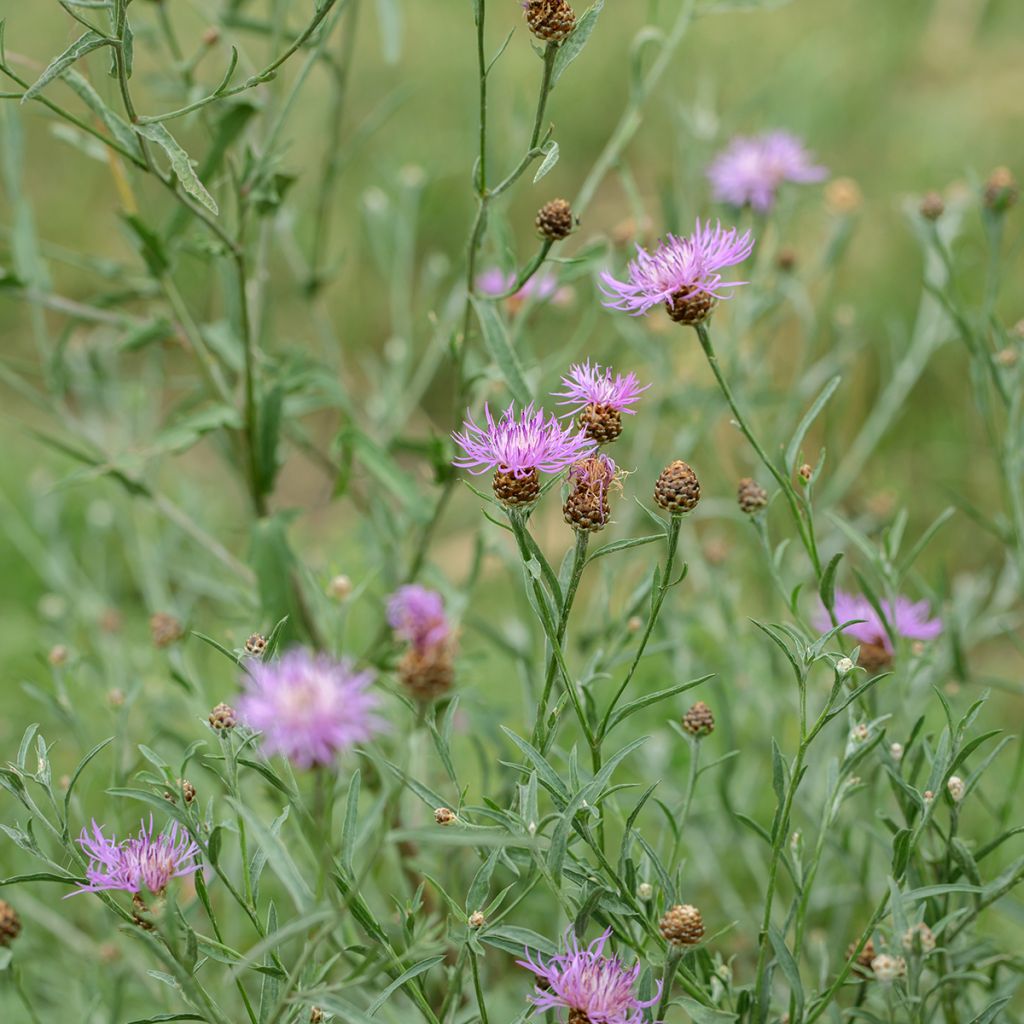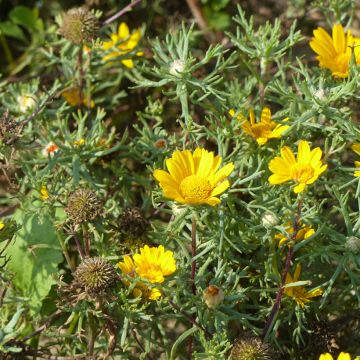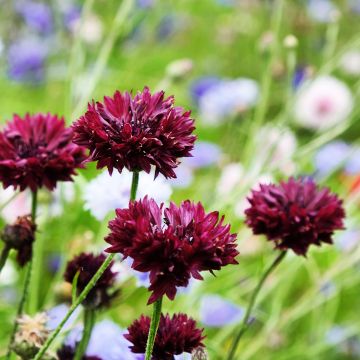

Centaurea cyanus Classic Romantic - seeds


Centaurea cyanus Classic Romantic - seeds
Centaurea cyanus Classic Romantic - seeds
Centaurea jacea
Brown knapweed, Rayed knapweed
This item cannot be shipped to the selected country
Dispatch by letter from €3.90
More information
Schedule delivery date,
and select date in basket
This plant carries a 6 months recovery warranty
More information
We guarantee the quality of our plants for a full growing cycle, and will replace at our expense any plant that fails to recover under normal climatic and planting conditions.
Seed-only orders are dispatched by sealed envelope. The delivery charge for seed-only orders is €3.90.
Does this plant fit my garden?
Set up your Plantfit profile →
Description
Centaurea cyanus Classic Romantic, also called cornflower or bachelor's button, is a mixture of pink and white, and sometimes bicoloured, single or semi-double flowers. Just like the adorable annual weed which once so widespread in our countryside and cornfields, they paint a simple but unforgettable picture. These cornflowers are very decorative in large drifts, perfect in wildflower compositions and bloom for months on end if flowers are removed as they fade. They like full sun and fertile, well-drained soil.
Cornflowers of the 'Classic Romantic' mix belong to the family Asteraceae. It is a selection of cultivars derived from Centaurea cyanus, an annual herbaceous plant native to Europe and North Asia that has long been considered an invasive weed in cereal crops and is one of the most beautiful wildflowers. It forms an upright clump of tender stems, reaching 65 cm high and 30 cm wide with very narrow, long, greyish-green leaves. The flowering period lasts from June to August with semi-double or single flower heads, 3 cm across. The ligulate flowers (or the petals surrounding the centre) are toothed at their tips and come in a blend of colours ranging from pure white to carmine red, including Indian pink and hot pink. Some flowers are bicoloured, displaying shades of white and pink. The centre of the inflorescence is made up of dark purple florets. The flowers are very nectar-rich.
Cornflowers are enchanting in flowerbeds where they form remarkable patches of colour. The 'Classic Romantic' mix, delightful descendants of the most famous of them all, brings the charm of the countryside to our gardens. Sow cornflowers in natural-looking beds, combined with ornamental grasses such as Stipa tenuifolia or Muhlenbeckia capillaris, catnips, pink love-in-a-mist, California poppies and purple cornflowers. The edible flowers can be used to decorate summer salads. It is also an excellent cut flower.
Report an error about the product description
Flowering
Foliage
Plant habit
Botanical data
Centaurea
jacea
Asteraceae
Brown knapweed, Rayed knapweed
Centaurea pratensis
Western Europe
Other Centaurea seeds
Planting and care
Sow cornflower 'Classic Romantic' seeds outside, in their final positions, in March-April. Choose a sunny spot with well-drained soil that has been well-prepared and raked to a fine tilth. Sow thinly, to a depth of 3 mm, spacing the seeds 30 cm apart. Water regularly, especially during dry periods. Germination usually takes 14-21 days. When the cornflower seedlings are large enough to be handled, transplant them 15 cm apart. An alternative is to sow them indoors from August to September to obtain blooms at the beginning of summer, the following year. Sow the cornflowers on the surface of good quality soil at a temperature of 18-23 °C, and cover with a sprinkling of very fine garden compost or vermiculite. Keep the seedlings in the light as this helps germination. When the seedlings are large enough to be moved, transplant and grow them in a place sheltered from the cold until the seedlings are large enough to be moved outside. Grow the cornflower seedlings in a frost-free place before planting out the following spring, or pricking them out in pots. Cornflowers thrive in fertile, well-drained, fine soil, in full sun.
Sowing period
Intended location
This item has not been reviewed yet - be the first to leave a review about it.
Flower seeds
Haven't found what you were looking for?
Hardiness is the lowest winter temperature a plant can endure without suffering serious damage or even dying. However, hardiness is affected by location (a sheltered area, such as a patio), protection (winter cover) and soil type (hardiness is improved by well-drained soil).

Photo Sharing Terms & Conditions
In order to encourage gardeners to interact and share their experiences, Promesse de fleurs offers various media enabling content to be uploaded onto its Site - in particular via the ‘Photo sharing’ module.
The User agrees to refrain from:
- Posting any content that is illegal, prejudicial, insulting, racist, inciteful to hatred, revisionist, contrary to public decency, that infringes on privacy or on the privacy rights of third parties, in particular the publicity rights of persons and goods, intellectual property rights, or the right to privacy.
- Submitting content on behalf of a third party;
- Impersonate the identity of a third party and/or publish any personal information about a third party;
In general, the User undertakes to refrain from any unethical behaviour.
All Content (in particular text, comments, files, images, photos, videos, creative works, etc.), which may be subject to property or intellectual property rights, image or other private rights, shall remain the property of the User, subject to the limited rights granted by the terms of the licence granted by Promesse de fleurs as stated below. Users are at liberty to publish or not to publish such Content on the Site, notably via the ‘Photo Sharing’ facility, and accept that this Content shall be made public and freely accessible, notably on the Internet.
Users further acknowledge, undertake to have ,and guarantee that they hold all necessary rights and permissions to publish such material on the Site, in particular with regard to the legislation in force pertaining to any privacy, property, intellectual property, image, or contractual rights, or rights of any other nature. By publishing such Content on the Site, Users acknowledge accepting full liability as publishers of the Content within the meaning of the law, and grant Promesse de fleurs, free of charge, an inclusive, worldwide licence for the said Content for the entire duration of its publication, including all reproduction, representation, up/downloading, displaying, performing, transmission, and storage rights.
Users also grant permission for their name to be linked to the Content and accept that this link may not always be made available.
By engaging in posting material, Users consent to their Content becoming automatically accessible on the Internet, in particular on other sites and/or blogs and/or web pages of the Promesse de fleurs site, including in particular social pages and the Promesse de fleurs catalogue.
Users may secure the removal of entrusted content free of charge by issuing a simple request via our contact form.
The flowering period indicated on our website applies to countries and regions located in USDA zone 8 (France, the United Kingdom, Ireland, the Netherlands, etc.)
It will vary according to where you live:
- In zones 9 to 10 (Italy, Spain, Greece, etc.), flowering will occur about 2 to 4 weeks earlier.
- In zones 6 to 7 (Germany, Poland, Slovenia, and lower mountainous regions), flowering will be delayed by 2 to 3 weeks.
- In zone 5 (Central Europe, Scandinavia), blooming will be delayed by 3 to 5 weeks.
In temperate climates, pruning of spring-flowering shrubs (forsythia, spireas, etc.) should be done just after flowering.
Pruning of summer-flowering shrubs (Indian Lilac, Perovskia, etc.) can be done in winter or spring.
In cold regions as well as with frost-sensitive plants, avoid pruning too early when severe frosts may still occur.
The planting period indicated on our website applies to countries and regions located in USDA zone 8 (France, United Kingdom, Ireland, Netherlands).
It will vary according to where you live:
- In Mediterranean zones (Marseille, Madrid, Milan, etc.), autumn and winter are the best planting periods.
- In continental zones (Strasbourg, Munich, Vienna, etc.), delay planting by 2 to 3 weeks in spring and bring it forward by 2 to 4 weeks in autumn.
- In mountainous regions (the Alps, Pyrenees, Carpathians, etc.), it is best to plant in late spring (May-June) or late summer (August-September).
The harvesting period indicated on our website applies to countries and regions in USDA zone 8 (France, England, Ireland, the Netherlands).
In colder areas (Scandinavia, Poland, Austria...) fruit and vegetable harvests are likely to be delayed by 3-4 weeks.
In warmer areas (Italy, Spain, Greece, etc.), harvesting will probably take place earlier, depending on weather conditions.
The sowing periods indicated on our website apply to countries and regions within USDA Zone 8 (France, UK, Ireland, Netherlands).
In colder areas (Scandinavia, Poland, Austria...), delay any outdoor sowing by 3-4 weeks, or sow under glass.
In warmer climes (Italy, Spain, Greece, etc.), bring outdoor sowing forward by a few weeks.
























































